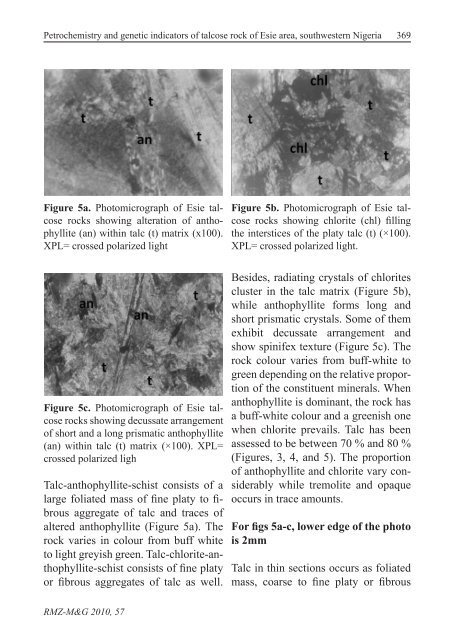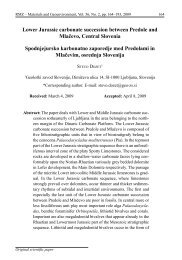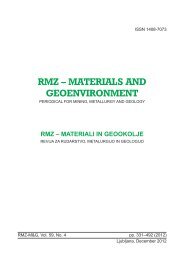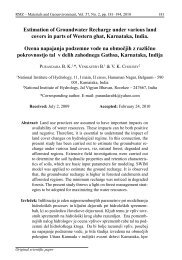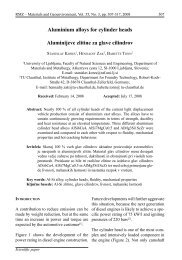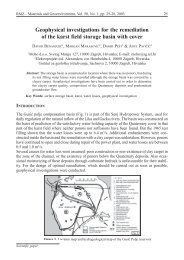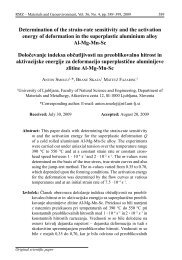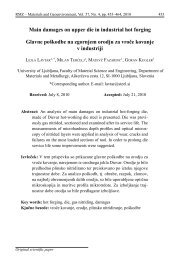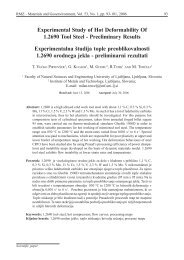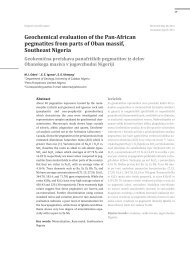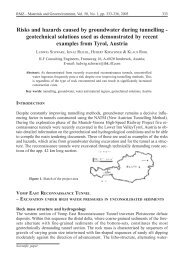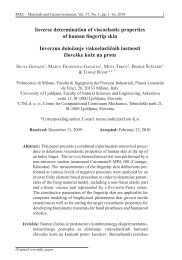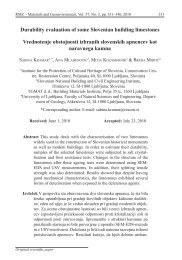Petrochemistry and genetic indicators of talcose rock of Esie ... - RMZ
Petrochemistry and genetic indicators of talcose rock of Esie ... - RMZ
Petrochemistry and genetic indicators of talcose rock of Esie ... - RMZ
Create successful ePaper yourself
Turn your PDF publications into a flip-book with our unique Google optimized e-Paper software.
<strong>Petrochemistry</strong> <strong>and</strong> <strong>genetic</strong> <strong>indicators</strong> <strong>of</strong> <strong>talcose</strong> <strong>rock</strong> <strong>of</strong> <strong>Esie</strong> area, southwestern Nigeria<br />
369<br />
Figure 5a. Photomicrograph <strong>of</strong> <strong>Esie</strong> <strong>talcose</strong><br />
<strong>rock</strong>s showing alteration <strong>of</strong> anthophyllite<br />
(an) within talc (t) matrix (x100).<br />
XPL= crossed polarized light<br />
Figure 5b. Photomicrograph <strong>of</strong> <strong>Esie</strong> <strong>talcose</strong><br />
<strong>rock</strong>s showing chlorite (chl) filling<br />
the interstices <strong>of</strong> the platy talc (t) (×100).<br />
XPL= crossed polarized light.<br />
Figure 5c. Photomicrograph <strong>of</strong> <strong>Esie</strong> <strong>talcose</strong><br />
<strong>rock</strong>s showing decussate arrangement<br />
<strong>of</strong> short <strong>and</strong> a long prismatic anthophyllite<br />
(an) within talc (t) matrix (×100). XPL=<br />
crossed polarized ligh<br />
Talc-anthophyllite-schist consists <strong>of</strong> a<br />
large foliated mass <strong>of</strong> fine platy to fibrous<br />
aggregate <strong>of</strong> talc <strong>and</strong> traces <strong>of</strong><br />
altered anthophyllite (Figure 5a). The<br />
<strong>rock</strong> varies in colour from buff white<br />
to light greyish green. Talc-chlorite-anthophyllite-schist<br />
consists <strong>of</strong> fine platy<br />
or fibrous aggregates <strong>of</strong> talc as well.<br />
Besides, radiating crystals <strong>of</strong> chlorites<br />
cluster in the talc matrix (Figure 5b),<br />
while anthophyllite forms long <strong>and</strong><br />
short prismatic crystals. Some <strong>of</strong> them<br />
exhibit decussate arrangement <strong>and</strong><br />
show spinifex texture (Figure 5c). The<br />
<strong>rock</strong> colour varies from buff-white to<br />
green depending on the relative proportion<br />
<strong>of</strong> the constituent minerals. When<br />
anthophyllite is dominant, the <strong>rock</strong> has<br />
a buff-white colour <strong>and</strong> a greenish one<br />
when chlorite prevails. Talc has been<br />
assessed to be between 70 % <strong>and</strong> 80 %<br />
(Figures, 3, 4, <strong>and</strong> 5). The proportion<br />
<strong>of</strong> anthophyllite <strong>and</strong> chlorite vary considerably<br />
while tremolite <strong>and</strong> opaque<br />
occurs in trace amounts.<br />
For figs 5a-c, lower edge <strong>of</strong> the photo<br />
is 2mm<br />
Talc in thin sections occurs as foliated<br />
mass, coarse to fine platy or fibrous<br />
<strong>RMZ</strong>-M&G 2010, 57


